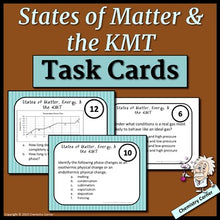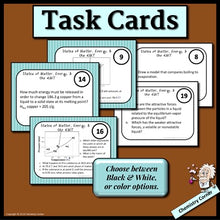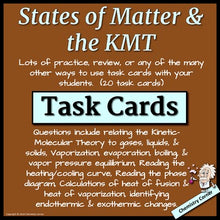You will find these States of Matter task cards to be a very versatile teaching tool. They can be used for practice with white boards, quizzes, partner or group work, or as an assignment in place of worksheets. Once they are cut out and laminated they will be a resource that can be used for years to come.
The task cards included in this packet include twenty cards. Included are questions on relating the kinetic-molecular theory to the states of matter, phases changes, ideal gases, reading the phase diagram and the heating/cooling curve, and calculations of the heat of fusion and heat of vaporization. Don’t teach all of these concepts? No problem! There are editable task cards included so that you can replace or add questions of your own. Differentiate these cards to meet your needs.
Two sets of task cards are included, one with a colorful background, and one for black and white printing. Also, you will find a set of edible cards (with color or B&W) that can be used to add cards to the set, or replace a card that you don’t want.
Differentiate this resource to meet your needs with the included editable task cards!
Lesson Objectives:
-
Give examples of conditions that cause gases to deviate the most from the ideal gas.
-
Relate the Kinetic-Molecular Theory to gases, solids, and liquids.
-
Define vaporization, evaporation, and boiling.
-
Relate the attractive forces, kinetic energy, and pressure are related to change of state.
-
Discuss the role of vapor pressure in changes of state between a liquid and its gas.
-
Calculate the amount of energy absorbed or released in order for a change of state to occur. (Hv, Hf)
-
Interpret a heating/cooling curve to identify melting point and boiling point, and phases.
-
Draw and Interpret a phase diagram to identify melting point and boiling point, triple point, and critical point.
-
Explain the phase diagram as a relationship between pressure and temperature.
-
Describe how equilibrium conditions are represented in a phase diagram.
-
Describe the relationship between energy and change of state in terms of endothermic or exothermic processes.
-
Identify the six changes of state, and the energy involvement associated with each change.
Prior Knowledge:
Knowledge of the states of matter with regards to particle arrangement, movement, and forces of attraction (particulars about bonding is not necessary—if you have not taught that yet).
Lesson Duration: One class period
Included in This Resource:
-
20 Task Cards (Black & White and with Color Background)
-
Editable task cards—B&W and Color
-
Student Answer Sheet
-
Complete Key with all problems worked out
-
Teacher Notes
Teacher Prep Time: Just print and go, or copy on card stock and laminate
These task cards are appropriate for grades 9-12 chemistry. Not appropriate for Middle School
You will want to use these task cards year after year!
Chemistry Corner
*************************************************************************************
Check out these other products that you may be interested in:
States of Matter & the Kinetic-Molecular Theory: Gases
States of Matter and the Kinetic Molecular Theory: Liquids
States of Matter and the Kinetic Molecular Theory: Solids
Chemistry Task Cards for the Year: A Growing Bundle
*************************************************************************************
LICENSING TERMS: By downloading this product, you own a license for one teacher only for personal use in your classroom. Licenses are non-transferable, meaning they cannot be passed from one teacher to another. No part of this resource is to be shared with colleagues or used by an entire grade level, school, or district without purchasing the proper number of licenses. I you are a coach, principal or district interested in transferable licenses to accommodate yearly staff changes, please contact beth@chemistrycorner.com.
COPYRIGHT TERMS: ©Chemistry Corner. Please note – all material included in this resource belongs to Chemistry Corner. By downloading, you have a license to use the material, but you do not own the material. This resource, or any portion of this resource, may not be uploaded to the internet in any form, including classroom/personal websites or network drives, unless the site is password protected and can only be accessed by students—no other teachers or anyone else on the internet.






